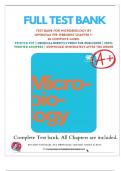,Table of Contents
., .,
1 An Invisible World
., ., .,
2 How We See the Invisible World
., ., ., ., ., .,
3 The Cell
., .,
4 Prokaryotic Diversity
., .,
5 The Eukaryotes of Microbiology
., ., ., .,
6 Acellular Pathogens
., .,
7 Microbial Biochemistry
., .,
8 Microbial Metabolism
., .,
9 Microbial Growth
., .,
10 Biochemistry of the Genome
., ., ., .,
11 Mechanisms of Microbial Genetics
., ., ., .,
12 Modern Applications of Microbial Genetics
., ., ., ., .,
13 Control of Microbial Growth
., ., ., .,
14 Antimicrobial Drugs
., .,
15 Microbial Mechanisms of Pathogenicity
., ., ., .,
16 Disease and Epidemiology
., ., .,
17 Innate Nonspecific Host Defenses
., ., ., .,
18 Adaptive Specific Host Defenses
., ., ., .,
19 Diseases of the Immune System
., ., ., ., .,
20 Laboratory Analysis of the Immune Response
., ., ., ., ., .,
21 Skin and Eye Infections
., ., ., .,
22 Respiratory System Infections
., ., .,
23 Urogenital System Infections
., ., .,
24 Digestive System Infections
., ., .,
25 Circulatory and Lymphatic System Infections
., ., ., ., .,
26 Nervous System Infections
., ., .,
, OPENSTAX MICROBIOLOGY TEST BANK OpenStax ., q .,q q
., .,q
., Microbiology THIS TEST BANK COVERS ALL CHAPTERS
q q
., ., q q
., q
., ., q q
.,
1-26 OF THE BOOK, Answered ., q q
., q
., q
.,
Chapter q1: qAn qInvisible qWorld ., ., ., .,
* q= qCorrect
., .,
., q answerqMultiple
.,
q
., Choice
1. Which qof qthe qfollowing qis qtrue qof qthe qmicrobial qworld?
., ., ., ., ., ., ., ., .,
A. All qmicrobes qare qharmful. ., ., .,
B. Humans qcould qsurvive qwithout qmicrobes. ., ., ., .,
C. Many qmicrobes qare qhelpful.* ., ., .,
D. Most qmicrobes qare qpathogenic. ., ., .,
Difficulty: qEasy .,
ASM qStandard: q23, q24
., ., .,
2. Which qof qthe qfollowing qis qwhen qhumans qfirst qsuspected qthe qexistence qof qmicrobes?
., ., ., ., ., ., ., ., ., ., ., .,
A. during qthe qIndustrial qRevolution ., ., .,
B. in qprehistoric qtimes*
., .,
C. in qthe qlast qcentury
., ., .,
D. within qthe qlast q500 qyears ., ., ., .,
Difficulty: qEasy .,
qASM qStandard:
., .,
q23
.,
3. Which qindividual qfirst qobserved qunicellular qorganisms, qwhich qhe
., ., ., ., ., ., .,
“animalcules,” qusing qa qmicroscope qhe qdeveloped?
qcalledq ., ., ., ., ., ., .,
A. Robert qKoch .,
B. Louis qPasteur .,
C. Thucydides
, D. Antonie qvan qLeeuwenhoek* ., .,
Difficulty: qEasy .,
qASM qStandard:
., .,
q6
.,
4. To qreduce qthe qrisk qof qopen qflame qfrom qBunsen qburners, qmicrobiologists
., ., ., ., ., ., ., ., ., .,
qareq
., increasingly qusing qwhich qof qthe qfollowing qdevices qfor qeasy, qrapid
., ., ., ., ., ., ., ., ., .,
qbenchtop qsterilization qof qsmall qpieces qof qequipment?
., ., ., ., ., ., .,
A. autoclaves
B. ethylene qoxide .,
C. incubators
D. microincinerators*
Difficulty: qEasy .,
qASM qStandard:
., .,
q36
.,




